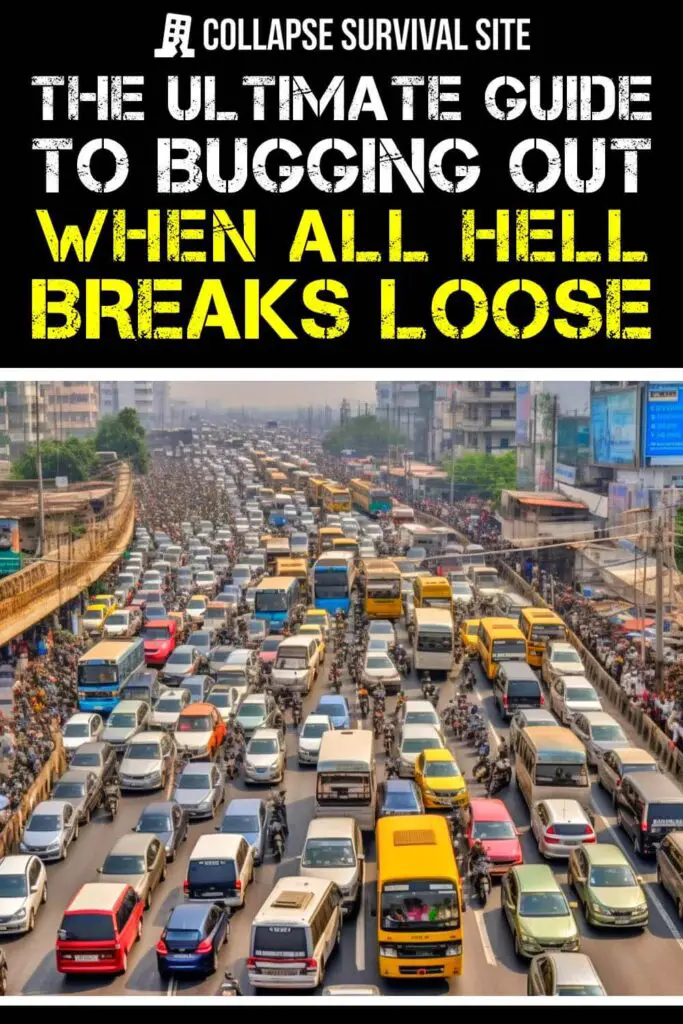Estimated reading time: 19 minutes
Why Bug Out?
The human race has been periodically bugging out for thousands of years. History is filled with stories of entire civilizations abandoning their homes and their homelands due to catastrophic natural disasters, wars, and pandemics. It’s nothing new, and neither are the natural and manmade disasters that plague us to this day.
We live in a time when the continent of Australia was being consumed by wildfires, a time when the Arctic and the Antarctic continue seeing record high temperatures, a time when wars are measured in decades rather than years, and a time when rogue countries are ruled by the raw rage of animal instinct.
Keeping Things in Perspective
If you look at the statistics, most bug outs are of short duration. Any evacuation brings with it a good share of stress and varying degrees of danger, but few evacuations are as desperate as the post-apocalyptic scenarios so popular on the Internet and in the movies.
Where real challenges begin to occur is when some disasters lead to others.
Want to save this post for later? Click Here to Pin It On Pinterest!
A natural disaster like an earthquake could lead to a tsunami resulting in widespread flooding and destruction, causing a breakdown of local law enforcement and support services leading to manmade disasters like rioting, arson, and looting. It’s an unfortunate and common pattern, and it’s why they’re called disasters.
4 Critical Factors Affecting a Successful Bug Out
Regardless of why you’re evacuating, there are 4 things to carefully consider before you make your move. Each will affect how you plan, prepare, and pack and whether or not bugging out is a viable option.
1. Situation
What’s going on? Is a natural disaster imminent or has it occurred? Are you in the midst of a manmade disaster with violent rioting, arson, and looting in the streets or all out war?
In a worst case scenario, one leads to the other with a natural disaster causing a collapse of local services and support leading to the spread of lawlessness and violence. It’s important to fully understand the situation and consider how it may evolve or deteriorate.
Situational Considerations
Situational considerations are typically defined by natural or manmade disasters.
Here are the most common natural disasters leading to a bug out:
- Weather related disasters including tornadoes, hurricanes, typhoons, flooding, wildfires and all of the associated challenges from power outages to compromised water and food supplies.
- Geological disasters related to earthquakes, volcanoes, tsunamis, landslides, and the devastation that accompanies them including widespread destruction of structures, services, roads, and bridges.
- Climate change affects temperatures and precipitation which affects local agriculture, health, and the economy. The dust bowl of the 1930s is a classic example of how a changing climate coupled with poor decisions affecting farming practices can have a devastating impact on the economy and quality of life.
- Epidemics and pandemics are nothing new. While COVID-19 may seem like a surprising occurrence to some, we were in the midst of two pandemics when COVID-19 first showed up. Both HIV/AIDS and Tuberculosis were identified by the World Health Organization as pandemics in the past decade and continue to affect many parts of the world while COVID rages. The last pandemic of note was the Spanish Flu of 1918. Pandemics will always be a fact of life… and death.
If there’s one thing true about manmade disasters, it’s that they endure. To this day, significant areas around Chernobyl, Fukushima, the Nevada desert, and even the Bikini Atoll in the South Pacific are still highly contaminated by nuclear radiation.
Civil wars and terrorism are a continuing threat, and many nations have suffered economic and social ruin for decades as a result. Here are some of the unfortunate and all too common manmade disasters that lead to bug outs:
- Civil unrest resulting in rioting, looting, arson and other random acts of violence. What makes this an increasing challenge is that it’s so unpredictable, both in terms of where it happens and the level of violence.
- Wildfires are often the result of arson or a complacent camper leaving a campfire unattended. The intensity of the wildfire and the threat is largely dependent on location and local conditions. The wildfires that continue to rage across the American West are fueled by weather conditions and geography.
- Terrorism occurs on a regular basis around the world, and while most terrorist incidents are hit and run, the potential for widespread and long-term threats from bio-terrorism, nuclear terrorism, and the emerging threat of cyber-terrorism and domestic terrorism can and will have long-term impacts.
- Pandemics occur because of the rapid and widespread infection of a large percentage of the population across multiple countries. When a virus first occurs in an area, it’s referred to as an outbreak. If it spreads across a country, it’s identified as an epidemic. What causes a virus to reach pandemic status is when the disease spreads across international borders and continues to spread.
- Economic collapse is a disaster that has affected societies for centuries. The Great Depression of 1929 created a generation of refugees as people lost their homes, farms, and livelihood and were relegated to living in shanty towns and on the streets. The Great Depression had a global impact, and future economic failures can have the same domino effect on currencies and economies around the world.
- War is a disaster of manmade origin and it affects every aspect of life. Civil war has reduced some countries to ruins, and a war between nations would have a devastating impact that could last for generations.
Extreme Disasters
- Extreme disasters fall in the category of solar storms; EMP bursts from space or nuclear detonations, asteroid strikes, super-volcanic eruptions, magnetic pole shifts and other stuff that sounds more like science fiction than fact.
Unfortunately, all are possible and the past has recorded extreme events actually occurring, although they occurred rarely over tens if not hundreds of thousands of years. In those cases, bugging out would most likely be a global event as the world’s population devolves to bands of nomadic refugees.
The simple truth is that no bug out bag could carry everything anyone would need for that level of events. Knowledge and skills would be the most valuable possessions.
Situational Planning
It may be impossible to plan for everything, but taking some time to assess realistic possibilities may allow for preparations that go beyond the obvious. How many preppers would have thought to pack surgical face masks and hand sanitizer before 2020? In the end it’s a personal decision but here are some thought starters:
- Do you understand the implications of nuclear and biological weapons either delivered as an act of war, terrorism, or an accident? Do you know what to buy, store, and pack if that is the event that creates a disaster situation?
- Are you prepared to survive in a barter economy in the event that traditional transactions are compromised by financial collapse? Do you know how to protect your investments and what kind of cash and coin to carry in addition to items that will define transactions in a barter economy?
- Do you have the knowledge, maps, and apps to navigate roads, highways and terrain that may be compromised by natural or manmade disasters? Do you know what to buy for basic navigation and have the skills to navigate using minimal resources and basic skills?
- Do you understand the nature of diseases that have pandemic potential and do you have the skills to recognize the symptoms and the equipment to protect your group? Do you have the knowledge and equipment to protect your group from disease spread by contact, food, water or the simple insect bites that plunged Europe into the Dark Ages with the Bubonic Plague?
- Do you have the knowledge, skills and equipment to defend yourself and your group? And it’s not just about guns. Do you have a full range of defensive equipment and the knowledge to keep yourself and your family safe?
- Do you have an escape plan that considers all of the routes and roads that will lead you to safety based on possible disaster scenarios? Have you also considered your plan B and plan C in case your planned route is compromised?
And while you’re at it, have you considered how and what you need to do to bug-in if there are simply no routes that can lead you to safety?
2. Location
While the “situation” is the most immediate threat motivating an evacuation, your location will often affect the degree to which the event affects you. Are you at the epicenter of a disaster, on the fringes, or well removed from events? Your location and how events unfold will have a significant effect on any decision to evacuate.
It can also be an advantage or disadvantage depending on the situational factors we just covered. Someone living in the Rocky Mountains may have little to fear from a tsunami caused by an earthquake, but rockslides and avalanches from that same earthquake are another matter.
The whole question gets down to determining where you will be safe or safer based on the situation and your location.
Locational Considerations
- Coastal locations are often subject to extreme weather disasters, particularly hurricanes and flooding and in some instances earthquakes, tsunamis, and volcanic eruptions given their proximity to tectonic plates, and wildfires fueled by off-shore winds.
- Inland locations may be spared the fury of oceanic weather and cataclysms but are no stranger to tornadoes, wildfires, and flooding and are equally threatened by pandemics, terrorism, civil unrest, and any other manmade disasters.
- Urban locations offer a mixed bag of advantages and disadvantages in the event of a disaster. An advantage is the population and the number of people both trained and untrained who are available to help. On the downside is that the number of people injured or missing forces a “triage” decision making process, leaving some people in the most desperate situations to fend for themselves.
Crime and violence often accompany disaster in cities but here again, the population size often mandates a rapid response. Any disaster resulting in widespread power outages would be the greatest threat, especially to city apartment dwellers.
- Suburban locations tend to be safer than most cities from a crime standpoint, but the ability of municipal services to provide aid during a disaster is proportional to the size of the suburb.
- Rural locations tend to offer more sustainable options and resources for water and food, but they are just as subject to both natural and manmade disasters. In many instances, rural areas are a destination for a bug out location. The small population reduces the general threat of crime and violence, but local resources can be severely limited including rapid responses to any kind of emergency.
- Wilderness locations are appealing for someone wanting to elude many manmade disasters, but they are also subject to natural disasters. Some of it depends on whether it’s a coastal or inland area, but the wilderness is also a favored destination for a bug out location.
The biggest disadvantage is the lack of local support services. You’re essentially on your own.
Location Planning
- Have you analyzed the greatest natural and manmade threats to your location? Try to prioritize them based on past history of disasters affecting your area. Have you assembled a plan, equipment, and supplies to survive in that area while evacuating and to sustain you at your destination?
- Are you sufficiently prepared at your bug out location and for how long? Some people chose to bug out for a month during the height of the COVID pandemic and were surprised to still be there a year later. If you have a fixed bug out location that you own, have you stocked it sufficiently and secured it?
- Have you determined your route from one location to another and developed contingency plans for reroutes or delays? A lot depends on your mode of travel. If traveling by vehicle, are you prepared to abandon the vehicle for whatever reason and proceed on foot?
- Have you thought about alternative means of transportation from one location to another? Planes, trains, buses, and ships come to mind. Traveling on foot has advantages and disadvantages. So does traveling in your car. If you have to find a middle ground, is a plane or train a possibility as a safe and reliable mode of travel to at least get you closer to your destination? Don’t assume that all services will be compromised. It will always vary.
- Is your bug out location still safe? Disasters have widespread impacts. Do you have a way to evaluate the security and safety of your bug out location before you depart? You don’t want to bug out into a worse situation than the one you just left.
3. Complications
Nothing’s easy, and evacuating in the midst of a crisis makes everything harder. But for some of us, the challenges exist even before we’ve decided to evacuate.
- You need to evacuate, but your mother-in-law is in a wheelchair.
- You’re ready to go in a fully loaded, top-of-the-line SUV, but the highways are parking lots and the side streets are shooting galleries.
- You’re in top physical condition, but you’re traveling with 3 small children.
- You or someone in your group has a chronic medical condition or disability.
Most families are confronted with at least one complicating possibility. And while it may seem like a good reason to stay put, some situations require an evacuation. This brings up another question relating to how you would deal with any complications that would compromise your ability to flee to safety.
Considering Complications
- Is everyone in your group in good health and fit for an arduous and potentially stressful journey?
- If someone gets injured during your evacuation, have you marked hospitals or temporary medical facilities on your map?
- Is there specialized equipment you should purchase that will help someone who is handicapped to navigate harsh terrain?
- Have you thought about the special needs of children and have you considered what they should have in their dedicated bug out bags?
- Is there anyone in your group that needs regular medications or therapy? Pharmacies may be few and far between, and services for physical therapy may be unavailable. Have you thought about how you can stock up on prescription meds and how you will get them in the future in addition to any physical needs related to therapy or equipment?
4. Duration
Perhaps the most critical consideration for any evacuation, regardless of the reason, is the duration. If you’re evacuating for a short period of time due to a natural disaster, your bug out preparations could be as simple as the bug out bag recommended as a 72-hour kit by FEMA.
If the duration is long-term, you can add it to your list of complications, especially if the motivation for the evacuation is manmade like war, economic collapse, or terrorism.
Duration Considerations
- If you are ordered to evacuate, have you asked when you can return? The unfortunate official response always seems to be indeterminate or along the lines of “when everything is over.”
- Do you appreciate the importance of sustainability? You may have a trunk full of bottled water, but do you have the necessary equipment and knowledge to find, purify, and store water when your water supply runs out?
- Do you have basic hunting, fishing, foraging, and gardening skills and equipment along with a supply of seeds in case you find yourself forced to survive for months without food?
- Can you effectively communicate and receive communications? Families are frantic during any evacuation, especially if a loved one is out of reach or their condition is unknown. The simple ability to receive radio broadcasts can mean the difference between avoiding danger or heading directly towards it.
- Do you have an estimation of when you can return? All bug outs come to an end. Most have a happy ending with a return to home. Others can result in a new life in a new place to call home. Having an idea of when it’s over can help a group get through the stress and emotional challenges of an evacuation.
This is especially important if you have children who will inevitably ask again and again, “When can we go home?” Your return should be just as carefully planned as your departure. The good news is that most things will be returning to normal but there are always pockets and areas you may want to avoid on the journey home.
Critical Steps to a Successful Bug Out
Beyond the common-sense of planning are the necessary steps to prepare for an evacuation. This should not be a last minute effort but a methodical assembly of the things you need to make an evacuation successful.
The Bug Out Bag
There should be no debate about it. Everyone should have a bug out bag. FEMA recommends it. Local authorities recommend it. Common sense demands it.
Recent natural disasters related to wildfires, flooding, and the ever-present threat of hurricanes along coastlines make it a reasonable and rational item for any household. But it’s a complex solution and a lot of factors need to be considered so your bug out bag decisions are done right the first time.
Basic Bug Out Bag Checklist
Let’s start by determining the best items for a bug out bag. We’re going to do this by category for all the things you’ll need, and you can drill down on the link above for more detail.
- Communication and Navigation
- Compass, maps, walkie talkies, cell phones, solar powered radio, solar power bank and cables to recharge electronics, portable ham radio. Pre-loaded apps on phones for navigation, medical and survival info.
- Fire and light
- Lighter, Fire steel, hand-cranked flashlight, candles.
- Food and water
- Cook kit, canteen, water purification tablets and equipment, backpacking food, MRE’s, seeds for long-term planting, hunting and fishing equipment.
- Medical supplies
- First aid kit, OTC medicines, prescription meds, first aid book.
- Personal hygiene
- Washing, dental, shaving, sunscreen, toilet paper.
- Shelter and clothing
- Tent, sleeping bag, rain gear, 2 changes of clothes, Mylar blankets.
- Tools and weapons
- Hatchet, saw, knife, handgun, rifle, ammo, multi-tool, folding shovel.
- Miscellaneous items
- Duct tape, insect repellent, cash, survival guide, critical identification and very important papers and documents.
What About the Kids?
Many items in a kid’s evacuation kit need to be adjusted from OTC medicines with a child’s dosage to right-sized equipment like backpack, rain gear, hiking boots, even flashlights and utensils. A lot depends on the age of the child.
One challenge is for an infant or young toddler still in diapers. Disposable diapers will be a luxury that can quickly run out in the long term. Cloth diapers are a mess but in an emergency everything tends to be messy and they are sustainable given their repeated use after washing.
And don’t forget about pets. They’re part of the family as well.
Urban Bug Out Considerations
- Move fast. In urban environments, the first out will have an advantage. It’s a good reason to travel light and make sure you’re not overloaded.
- Be aware of urban hazards. It’s possible you will be travelling through areas of dust and debris. Think about what you’ll need to travel through that kind of environment, from work gloves to dust masks and a crowbar.
- Be gray. Don’t call attention to yourself. Keep a low profile and blend in.
- Be a threat. Not a target. You’ll run into more people in the city than the wilderness and many will be desperate. Make sure your group looks strong, be aware of your surroundings, and keep a low profile when possible.
- Trust your instincts, not the mob. Follow your plan, not the crowd. If the crowd is traveling on your predetermined path, go with the flow.
The Best Bug Out Vehicle
Up to now, we’ve focused on the bug out bag and the idea that you would be walking away from your disaster. What’s more likely is that you would get your family in the car or truck and drive from the disaster area. Here a link to more information about the best bug out vehicle.
You may not be able to address all of these considerations, but if you have the option to easily accommodate some of them it would be a good idea. This video covers more detail on how to make the most of any vehicle for a bug out.
On the Road Realities
Pre-planning and careful mapping of alternative routes is certainly a critical success factor, but there are other factors that can affect your survival, especially when you’re on the road. One of them are all the things to keep in mind when you’re camping on your way to your bug out location.
Even if your destination is only a hundred miles away, everything from traffic jams to roadblocks due to a natural disaster can slow your progress and cause you to stop for a day or the night or longer.
Camping while you evacuate may be necessary, and it will always be the greatest risk because it leaves you exposed with minimal resources. That’s one of the reasons self-defense needs to be considered, especially in desperate times.
There are a couple of weapons you should take along when you bug out to not only get you through the trip, but to hunt and provide defense at your bug out location.
Bugging Out On Foot
There’s a lot of advice on the Internet recommending a bug out on foot. The biggest reason is that roads quickly become jammed during an evacuation and in some instances, the roads are out or blocked by debris or flooding.
Unfortunately, bugging out on foot can be equally challenging. For one, you’ll be traveling very slowly. This is especially true if you’re traveling with children. You’re also exposed to both weather and violence. In a vehicle, you’re more protected from the elements, and if you’re confronted by crime or violence, you can always hit the gas to escape.
But even in a vehicle, it’s possible you may have to abandon the car and set out on foot. Vehicles break down, get stolen, damaged, or just run out of gas where there’s no way to refuel.
If you do bug out in a vehicle, make sure you have a plan B for continuing on foot. That’s the biggest reason to pack your gear in a backpack rather than a suitcase or duffel bag or just throwing it in the trunk.
The Best Bug Out Location
These considerations vary depending on the situation, but let’s assume the worst case scenario.
- Security. How defendable is the location?
- If isolated and not occupied, is it sufficiently locked up and secure?
- Camouflage. How hidden is the location?
- Water. Is there a natural source close by?
- Hygiene. How will you keep clean? Bathroom facilities? Bathing?
- Is it an all season location and shelter for winter, spring, summer and fall?
- Are there food resources including fishing, hunting, wild foraging and gardening?
- Does it have alternative sources for electric power and heat including solar, wind, or water generated power, firewood or other alternative heat sources?
The greatest risk may occur immediately after disaster strikes and before you get there. It can get discouraging, but there are ways to defend your property as well as yourself.
Not all disasters lead to an intense level of violence. Day to day life for most people during the height of the pandemic was more along the lines of boredom and cabin fever.
If You Don’t Have a Bug-Out Location…
- Public lands in another state
- Extended stay hotels
- National and state park campgrounds
- Your vehicle, RV, or trailer home
- Mines are a possibility, but you might have company. Abandoned mines are also very dangerous.
- Ghost towns are a possibility, but here again, you may not be alone.
- Factories and warehouses may be abandoned depending on the nature of the disaster.
One obvious observation with any of these locations is that they are only suited for a short-term evacuation and occupation. Over the long term, they will attract more and more people. And if there is no law enforcement, things could get dangerous quickly.
It Won’t Be Easy
Evacuations are never simple. They are the direct result of chaotic events. The only way to survive the chaos is to take the time to anticipate, plan and prepare. Hopefully the worst that happens is an uncomfortable bug-in while wait for things to stabilize. Unfortunately, and all too often, history has shown that bug outs are an inevitable fact of life.
Like this post? Don't Forget to Pin It On Pinterest!








